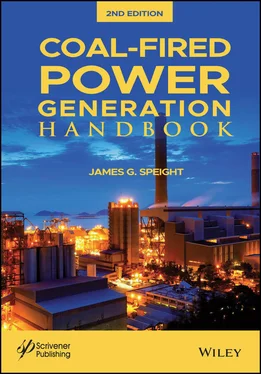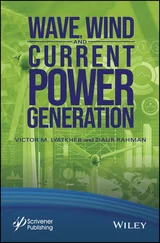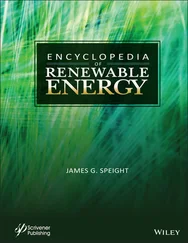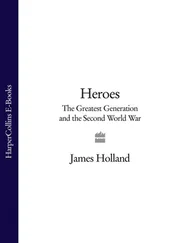Oxidation also leads to the formation of various oxygen functional groups and soluble inorganic that can adsorb on the coal surface and modify its wettability and floatability. These groups have remarkable impacts on surface charge, which controls film-thinning process and thus flotation kinetics (Sokolović et al. , 2006). Decreased coal recovery and increased concentrate ash content may be explained by oxidation of coal. In fact, a good correlation exists between the zeta potential and floatability and electrochemical tests confirm the negative effect of oxidation on the coal recovery and also the final effect of coal flotation process (Fonseca et al ., 1993; Sokolović et al ., 2006).
The scheme used in physical coal cleaning processes varies among coal cleaning plants but can generally be divided into four basic phases: (i) initial preparation, (ii) fine coal processing, (iii) coarse coal processing, and (iv) final preparation (Figure 3.1).
For most coal-fired power plants, coal is prepared for use by first crushing the delivered coal into pieces less than 5 cm in size. The crushed coal is then transported from the storage yard to in-plant storage silos by rubberized conveyor belts. In the initial preparation phase of coal cleaning, the raw coal is unloaded, stored, conveyed, crushed, and classified by screening into coarse and fine coal fractions. The size fractions are then conveyed to their respective cleaning processes.
In plants that burn pulverized coal, coal from the storage silos is fed into pulverizing units that grind the crushed coal into the consistency of talcum and mix it with primary combustion air which transports the pulverized coal to the steam generator furnace ( Chapters 7, 8). A 500 MW coal-fired power plant will have approximately six such pulverizing units, five of which will supply the steam generator at full load with approximately 225 tons per hour. In plants that do not burn pulverized coal, the crushed coal may be directly fed into cyclone burners, a specific kind of combustor that can efficiently burn larger pieces of coal ( Chapters 7, 8). In plants fueled with slurried coal, the slurry is fed directly to the pulverizing units and then mixed with air and fed to the steam generator. The slurry water is separated and removed during pulverizing of the coal.
Fine coal processing and coarse coal processing use similar operations and equipment to separate the contaminants. The primary difference is the severity of operating parameters. The majority of coal cleaning processes use upward currents or pulses of a fluid such as water to fluidize a bed of crushed coal and impurities. The lighter coal particles rise and are removed from the top of the bed. The heavier impurities are removed from the bottom. Coal cleaned in the wet processes then must be dried in the final preparation processes.
Final preparation processes are used to remove moisture from coal, thereby reducing freezing problems and weight and raising the heating value. The first processing step is dewatering, in which a major portion of the water is removed by the use of screens, thickeners, and cyclones (Hee and Laskowski, 1994; Nowak, 1994). The second step is normally thermal drying, achieved by any one of three dryer types: (i) fluidized bed drying, (ii) flash drying, and (iii) multi-louvered drying. In the fluidized bed dryer, the coal is suspended and dried above a perforated plate by rising hot gases. In the flash dryer, coal is fed into a stream of hot gases for instantaneous drying. The dried coal and wet gases are both drawn up a drying column and into a cyclone for separation. In the multi-louvered dryer, hot gases are passed through a falling curtain of coal, which is then raised by flights of a specially designed conveyor.
Although inherent moisture cannot be changed, the surface moisture can be reduced to any level that is economically practicable. Considerations include the possibility of re- exposure to moisture during transportation and subsequent storage and the fact that intense thermal drying increases ideal conditions for re-adsorption of moisture.
The free sulfur in the coal is subject to removal only by chemical treatment, which is not a coal preparation process, or by combustion. The reason that the pyrites can be partially removed in washing processes is that they are heavy enough to be removed with the ash. The processes can remove only 30 to 60% of the pyrites, however, because some pyrites are not broken free of the coal and are present in a given piece in a quantity too small to increase its weight enough to be rejected.
Foreign metals can be removed relatively easily. Most wood fragments can be removed although a few small pieces of wood cause no particular harm because they are combustible.
Thus, coal preparation is, of necessity, an integral part of the production and use of coals. The effect on costs can be as important as the planning of mine layouts; decisions concerning mining systems should be an essential element in all mining feasibility studies, especially in view of new (and/or renewed) environmental regulations such as the Clean Air Act Amendments in the United States (Elliott, 1992; Tumati and DeVito, 1992; Rosendale et al. , 1993; Paul et al. , 1994).
In more general terms, the primary aims of preparing coal for the market depend upon the nature of the raw coal ( Table 3.4; Figure 3.1) but, essentially, are (i) the reduction in size and control of size within the limits determined by the needs of transportation, handling, and utilization; and (ii) the removal of extraneous mineral matter to a point that is satisfactory for the customer and specifications are met. This latter operation is more often referred to as control of ash content.
In the early days of the industry, coal was sold as it came from the ground but as the century advanced there was always the possibility of dispute related to payment if the coal contained visible impurities, including excess water above the amount specified in the purchasing contact. Thus, in the early-to-middle decades of the last century, some effort was made to physically remove the impurities from the coal as evidenced by the employment of belt boys . It was the sole purpose of these boys, hired straight from school, at age 12 to 15 (sometimes even younger!) to stand at the side of the underground conveyer belts and remove (by hand) the pieces of rock and slate as the coal passed to the mine cars. By this means, much of the large-sized impurities were sorted and left in the waste area.
Table 3.4 General methods of coal preparation and levels of cleaning (Speight, 2013).
| Level |
Raw coal weight (%) |
Raw coal content (%) |
Reduction potential |
Comments |
| Ash |
Sulfur |
| 1 |
98–100 |
99–100 |
None to minor |
None |
Crushing and breaking of raw coal to 3-in. size |
| 2 |
75–85 |
90–95 |
Fair to good |
None to minor |
Coarse coal cleaning of 3 in. × 3/8 in. coal |
| 3 |
60–80 |
80–90 |
Good |
Fair |
Moderate coal cleaning of 3 in. × 28 mesh coal |
| 4 |
60–80 |
80–90 |
Good to excellent |
Fair to good |
Fine coal cleaning of 3 in. × 0 mesh coal |
| 5 |
60–80 |
85–95 |
Deep-cleaned coal: excellent; middle-cleaned coal: none so far |
Multiple-stream coal preparation of two cleaned coal products: “deep-cleaned” coal and “middle grade” coal |
In many mines, the waste areas are called tipples because of the operation which transferred the coal from the mine cars to picking or sorting screens and where visible impurities were removed by hand. Tipples also segregated the run-of-mine coal into size groups and, as the larger sizes could be more carefully hand-cleaned and were burned with greater ease and cleanliness in fireplaces and hand-stoked furnaces, size became associated with quality. The tipples grew to become environmentally unsuitable mountainous heaps of rock which still disfigure many coal-mining areas. Recently, there have been efforts to take back much of the tipple rock into the worked-out underground seams for storage.
Читать дальше












